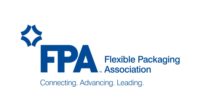The Flexible Packaging Association is leading an industry effort to address end-of-packaging–life alternatives for flexible packaging including resource recovery for multi-material laminates. The goal of the FPA Resource Recovery Program is to evaluate current and emerging technologies, explore potential business models, and expand communication and outreach efforts to facilitate flexible packaging waste (FPW) resource recovery technologies.
FLEXIBLE PACKAGING RESOURCE RECOVERY – CONTINUING THE JOURNEY
The Flexible Packaging Association (FPA) Resource Recovery Consultant Peter Hunderup, presented the most recent findings from ongoing FPA research regarding flexible packaging end-of-packaging-life issues to over two-hundred attendees of the Smithers Pira Sustainability in Packaging Conference in early March. Hunderup was joined by FPA members, Ampac and Bemis Company, Inc. for a panel discussion on Key Sustainability and Innovation Trends around Flexible Packaging for Better End of Life Scenarios. The panel reviewed trends in flexible packaging, recent market developments influencing packaging, and the sustainability of flexible packaging.
Hunderup’s presentation focused on FPA research to evaluate current and emerging technologies in resource recovery, including exploring potential business models for the viable recovery of multi-material laminates. In this phase of research, FPA worked with material recovery facilities (MRFs) and the waste management industry to expand the understanding of collection and sortation challenges and opportunities for resource recovery and to determine the level of technology and commercial development of emerging end market processors. Additionally, as part of the research, FPA has developed a list of stakeholder end-of-packaging-life programs and initiatives, to avoid redundancies and leverage learnings.
NOT ALL FLEXIBLE PACKAGING IS THE SAME
For resource recovery purposes, it is important to understand that not all flexible packaging is the same. Polyethylene bags and films and predominantly polyethylene laminates are currently recycled primarily through store drop-off programs. Multi-material laminates and films which provide barrier protection through the lamination of highly engineered materials, are more difficult to mechanically recycle. However they are excellent candidates for resource recovery. The challenges to their recovery include collection, sortation, and volume, which is only 1.6% of the municipal solid waste stream (Figure 1).
COLLECTION CHALLENGES
There are currently no documented programs for curbside collection of multi-material laminates in the U.S. Programs that accept PE bags or PE film do not accept laminates. Therefore, FPA is exploring the best methods for collection, sortation and processing.
SORTATION CHALLENGES
Cost effective sortation at the MRF is one of the biggest challenges facing recovery of flexible packaging. There are currently no established sortation methods for laminates, films or bags. Manual sortation, and vacuum-assisted manual sortation, are the primary methods currently used for sorting small volumes of flexible packaging inadvertently placed in recycling bins. Flexible packaging waste could be optically (auto) sorted at low through-puts, however, the low volume of flexible packaging waste makes it challenging for MRFs to justify adding a new sortation stream for these materials.
PROCESSING
Emerging technologies for processing end-of-packaging-life multi-material laminates include gasification, engineered solid fuels, and pyrolysis. Currently, pyrolysis appears to be a promising option for resource recovery of multi-material laminates.
Since collection, sortation, and processing are often unique to a given community, there is currently no single solution that can be applied to flexible packaging. A system’s viability will be influenced by existing equipment and infrastructure, material collection methods and rates, volume and mix of collected materials, the relative location of processors, and demand for recovered materials. Figure 2 illustrates possible material flows to accomplish resource recovery of multi-material laminates. Collecting laminates at a depot or during a separate pick-up could bypass the MRF and sortation issues, by going directly to the processor for conversion to energy alternatives. Bag-in-bag collection could facilitate single stream collection and sortation.
The Flexible Packaging Association is an industry leader in sustainability issues through its research initiatives and programs. For more details regarding our ongoing research and involvement in resource recovery, please see the FPA brochure Flexible Packaging Resource Recovery: A Work in Progress here.




